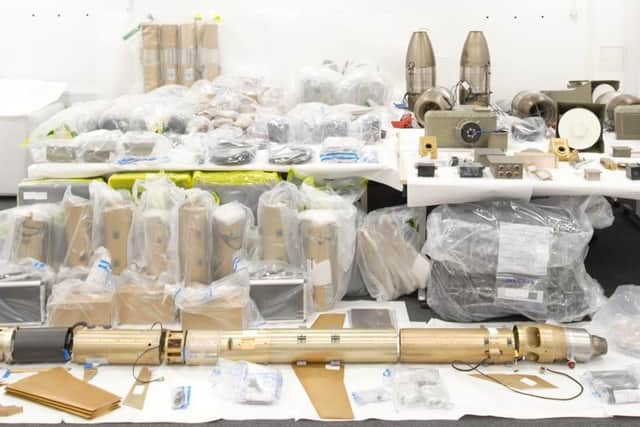Royal Navy's HMS Montrose intercepts shipment of Iranian missiles in Gulf of Oman - believed to be headed for Yemen
and live on Freeview channel 276
The British government statement was striking in so far as it provides some of the strongest findings to date that Iran is arming Yemen’s Houthi rebels against the Saudi-led military coalition with advanced weapons smuggled through the Persian Gulf.
The UK Embassy in the United Arab Emirates described the seizure of surface-to-air-missiles and engines for land attack cruise missiles as ‘the first time a British naval warship has interdicted a vessel carrying such sophisticated weapons from Iran’.
Advertisement
Hide AdAdvertisement
Hide Ad

‘The UK will continue to work in support of an enduring peace in Yemen and is committed to international maritime security so that commercial shipping can transit safely without threat of disruption,’ James Heappey, minister for the armed forces, said.
Iran’s mission to the United Nations rejected the UK’s findings as ‘groundless’, saying that Iran had ‘never transported weapons or military equipment to Yemen’ in violation of the UN arms embargo and “always upheld its international obligations”.
The British government’s announcement signals an escalation as western officials have in the past shied away from public statements that definitively blame Iran for arming Yemen’s Houthis with military contraband.
But the route of the smuggled shipments through the Arabian Sea or Gulf of Aden has strongly suggested their destination.
Advertisement
Hide AdAdvertisement
Hide AdDespite a United Nations Security Council arms embargo on Yemen, Iran has long been suspected of transferring rifles, rocket-propelled grenades, missiles and other weaponry to the Houthis since the war began in 2015.
Citing a forensic analysis last month, the Navy linked the batch of rocket engines seized earlier this year to an Iranian-made cruise missile with a 1,000km range that it said the rebels had used against Saudi Arabia.
The Houthis also used the cruise missile to attack an oil facility in Abu Dhabi in January of this year, the Navy said, an assault that killed three people and threatened the key US ally’s reputation as a haven of stability.
The US military launched interceptor missiles during the attack, signalling a widening of Yemen’s war.
Advertisement
Hide AdAdvertisement
Hide AdHMS Montrose’s helicopter had been scanning for illicit goods in the Gulf of Oman on January 28 and February 25 when it spotted small vessels speeding away from the Iranian coast with “suspicious cargo on deck”.
A team of Royal Marines then halted and searched the boats, confiscating the weapons in international waters south of Iran.
A US navy guided-missile destroyer supported the Royal Navy warship’s February operation.
The Houthis seized Yemen’s capital, Sanaa, in September 2014 and forced the internationally recognised government into exile.
Advertisement
Hide AdAdvertisement
Hide AdA Saudi-led coalition armed with US weaponry and intelligence joined the war on the side of Yemen’s exiled government in March 2015.
Years of fighting have ground into a bloody stalemate and pushed the Arab world’s poorest nation to the brink of famine.
A tenuous truce that began around the holy Muslim month of Ramadan appears to be holding, although both sides have accused each other of violations.
